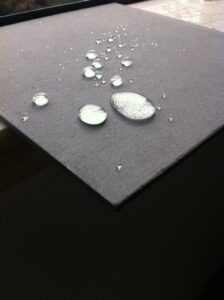
Fiber cement board, while naturally moisture-resistant, is not inherently waterproof on its own and often requires additional treatment for wet areas or exterior use.
Here are the main ways to waterproof fiber cement board, depending on the application (e.g., shower walls, exterior siding):
- For Interior Wet Areas (e.g., Showers, Tubs)
This is the most common application where complete waterproofing is critical, usually before tiling.
- Liquid Waterproofing Membrane (Topical Application):
- Apply a paint-on liquid membrane (like RedGard, Hydro Ban, etc.) over the entire surface of the installed fiber cement board. This typically requires two thick coats applied according to the manufacturer’s instructions.
- Before applying the membrane, all seams, joints, fastener heads/penetrations, and corners must be sealed and sometimes reinforced with mesh or fiberglass tape embedded in a waterproof thin-set mortar or a layer of the liquid membrane.
- Using Waterproof Cement Board:
- Some manufacturers offer special fiber cement backer boards with a proprietary waterproofing core
- When using these boards, you typically only need to apply the liquid waterproofing or sealant at the joints, seams, and fastener penetrations, which can save time and material compared to coating the entire surface.
- For Exterior Cladding/Siding
For exterior use, the waterproofing is usually achieved through the entire wall system, with the fiber cement board providing the weather-resistant finish.
- Primer and High-Quality Paint:
- The most common method for fiber cement siding is to prime the board with an alkali-resistant exterior primer (which seals the porous surface and aids paint adhesion) and then apply two coats of a high-quality, 100% acrylic exterior paint.
- Crucially, all site-cut edges of the fiber cement board must be primed and painted (or sealed) before installation or as part of the process, as these edges can be very absorbent.
- For high-humidity or high-rainfall regions, some experts suggest considering an elastomeric coating for an extra layer of protection.
- Wind and Water Barrier (Behind the Board):
- For exterior walls, the primary waterproofing is done by installing a wind and water-resistant barrier/house wrap (like a breathable waterproof membrane) directly behind the fiber cement board and over the structural sheathing. The fiber cement acts as a durable, finished facade that manages bulk water, while the barrier provides the final line of defense against moisture penetration.
General Steps for Waterproofing Fiber Cement:
- Preparation: Ensure the board surface is clean, dry, and free of dust, oil, or debris.
- Seal Gaps and Joints: Fill any large gaps or cracks with an appropriate sealant or concrete mix.
- Reinforce Seams (Wet Areas): For wet areas, apply reinforcing tape or mesh over all seams and corners, typically embedding it in a layer of the waterproofing membrane or thin-set mortar.
- Apply Waterproofing/Primer: Apply the chosen liquid waterproofing membrane (for wet areas) or an alkali-resistant primer (for painting/siding) according to the product’s instructions, ensuring all surfaces and cut edges are covered.
- Apply Final Coats: Follow up with a second coat of the liquid membrane or the two coats of high-quality exterior paint.
28
OCT
2025
OCT
2025
0
